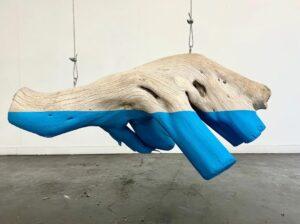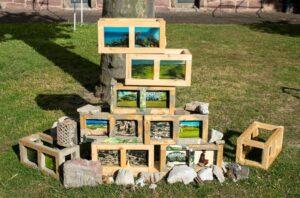The Art Year in Review: When private initiative rules-Part 1

While the picture with regard to handling of the arts, heritage and culture in the public sector was dismal here in Jamaica, there was a heartening level of private initiative in 2022, most of it led by contemporary artists, with a return to pre-pandemic levels of activity.
The third and fourth edition of And I Resumed the Struggle (AIRTS) exhibitions at the Olympia Gallery were among the highlights of the year. Edition three had actually opened in late 2021 but continued until the end of January 2022, while edition four continued until the end of January 2023. The first AIRTS exhibition was held in late 2020, as the first major live art event in Jamaica after the pandemic lockdowns and was framed as an existential reflection on that cultural moment. The concept of engaging with the “cultural now” has remained as a central premise of the AIRTS exhibitions and the most recent, fourth edition was, for instance, presented as a reflection on Jamaica at 60 years of independence, under the title (In)Dependence, although this theme was not consistently evident in the works on display. The latter is increasingly a problem with thematic exhibitions, where the expedience of a catchy title and trendy but shallow exhibition concept often takes precedence over the curation and actual content of the exhibition.
The AIRTS exhibitions are organized by an informal artists’ collective, of which Phillip Thomas and Camille Chedda serve as the lead curators. The list of participating artists has changed for each exhibition, but has typically also included Greg Bailey, Kimani Beckford, Khalfani Ra, Oneika Russell, John Campbell and Omari Ra, along with a changing cast of recent art school graduates and other occasional participants, such as Petrona Morrison and Prudence Lovell in the third edition. Each edition has also been accompanied by live-streamed discussion panels and artist talks, with exemplary use of low-cost exhibition technologies such as QR codes with extended label information and short video presentations by the artists and an active presence on Instagram. The first three editions also had online catalogues.

Most of the artists who have exhibited in the AIRTS exhibitions are associated with the Edna Manley College, as graduates or as lecturers, and in some instances as both, which illustrates the extent to which the College continues to shape current directions in Jamaican art – a crucial role for which it is not always recognized. Some of the participating recent graduates have simply exhibited graduation work. Others, such as Brad Pinnock, Sasha Kay Hinds, Trishauna Henry, and Tevin Lewis, have presented new work, which is important as taking the step from art school student to practicing artist is a notoriously difficult one, especially in an environment where support for that crucial moment is lacking. Past initiatives such as Mutual Gallery’s Under-40 Artist of the Year competition and the National Gallery of Jamaica’s Young Talent exhibitions are sorely missed for that same reason.
By now there is, however, an inevitable sameness to the AIRTS editions, given the participation of the same cadre of core artists. A stronger, more selective curatorial approach seems to be in order to keep the exhibitions relevant in the long run, but I understand that new strategies are being explored. The series, indirectly, also highlights some of the problems that currently face the Jamaican art world, with the lack of suitably equipped exhibition space as a key example. The Olympia gallery has the advantage of size, but it is hardly ideal for art exhibitions in terms of the unconventional layout, limited wall-space, and lack of gallery-standard climate-control and lighting. These concerns notwithstanding, the AIRTS exhibitions are an important platform for contemporary Jamaican art, at a time when local opportunities are limited, and I hope that the initiative will continue in 2023.

Another important initiative is the Inpulse Art Project, which is managed by Camille Chedda and supported by the Rubis Mécénat, a French fund associated with the Rubis Group that also supports similar social committed art projects in South Africa and Madagascar. Inpulse, which was established in 2015, offers free art workshops, scholarships, residencies for visiting artists, and opportunities to participate in local and international art events. Several promising young artists, namely Jordan Harrison, Sasha Kay Hinds, Demar Brackenbridge, and Sheldon Green, have already come through the programme and are now graduates of the Edna Manley College.
The Inpulse programme for this year included a film workshop with Nile Saulter in September-October, during which a short film, entitled Without Fail, was produced. There were also two artist-in-residence programmes, both presented in association with the Edna Manley College, with which Inpulse regularly collaborates. One involved Johanna Castillo, an artist from the Dominican Republic, who works with recycled textiles and who produced a collaborative installation at the Edna Manley College. The Dominican curator and art writer Yina Jimenez Suriel was part of this project, and both were involved in a panel discussion while the latter also presented a lecture on her curatorial work.
The second involved the French installation artist Stéphane Thidet and the Haitian artist Reginald Sénatus who, working with a group of Inpulse and Edna Manley College students, produced a hauntingly beautiful collaborative installation made from driftwood, entitled Staying Afloat, which was shown at the College. The statement which accompanied Staying Afloat is worth quoting at length, as it effectively captures the process and intent of the project. “Staying Afloat began with our journey to the shore to collect driftwood from Bull Bay. We selected interesting pieces of wood that, upon reflection, echoed human scale and were biomorphic. These fragments of the landscapes were already transformed by nature, but we wanted to use them in a way that unified us as a collective. [The resulting installation] drew allusions to Jamaica’s current situation in the context of migration, climate change, and the histories embedded in the Caribbean Sea. Each sculpture also demonstrates how humans can accomplish the seemingly impossible. If we cannot swim, we can fly.”
Writing effective artist statements is a necessity for participation in the contemporary art world and such skills need to be fostered, a process to which Inpulse also contributes. Thidet and Sénatus also gave talks at the Edna Manley College.
In the summer, Camille Chedda, Demar Brackenridge and Sheldon Green had furthermore participated in the Documenta 15 exhibition in Kassel, Germany, at the invitation of the Atis Résistanz/Ghetto Biennale collective from Haiti. Inpulse had previously participated in the Ghetto Bienniale, an initiative that has self-empowered and given significant international exposure to urban artists from Port-au-Prince, Haiti. Last year’s ground-breaking, if controversial, edition of Documenta, which is an influential international art event, consisted of non-profit, social activist artist collectives from all over the world invited by that year’s guest curators, the Ruangrupa Art Collective from Jakarta in Indonesia. I will write more about that event, and the Caribbean collaborations it involved, in a forthcoming column.
While Inpulse reaches a fairly small number of participants, it sets an important local standard with a programme that mentors and supports young artists from high school into their professional life as artists and fosters exemplary and well-informed professionalization practices and exposure to the international art world. It is a great example of how artists’ initiatives and corporate arts patronage can interface productively and the positive results for the participating artists and the development of contemporary Jamaican art are already evident. My only regret is that there are no other such initiatives elsewhere in Jamaica.
Dr Veerle Poupeye is an art historian specialized in art from the Caribbean. She works as an independent curator, writer, researcher, and cultural consultant. The second, revised and expanded edition of her best-known book “Caribbean Art” was recently published in the World of Art series of Thames and Hudson. Her personal blog can be found at veerlepoupeye.com.






